- Basic OpenGL constructs we will use are the same:
- VAO/VBO geometry/attribute creation tools
- glUniform tools for per-primitive (uniform) attributes
- Primitive rendering API: glDrawArrays & glDrawElements
- Draw modes (GL_TRIANGLE_STRIP, GL_TRIANGLE_FAN, etc.)
- There are three important modeling tasks to address when we design a scene:
- Geometry modeling: create the geometry of the points and normal vectors that define the surfaces and other elements in our 3D scene.
- Attribute modeling: define the attributes associated with
the vertices and primitives in our geometry. The OpenGL API treats vertex coordinates and normal
vectors exactly like any other attribute. That is why we have just one type of VBO for all per-vertex
attributes. Nevertheless, we discuss them separately here because they are conceptually different and
they are specified in very different ways.
Non-geometric attributes include "obvious" things like colors, material properties, and texture coordinates as well as any sort of application-specific attribute you may want to associate and visualize on your model. How about stresses on a beam? Temperatures across a heat sink? The list goes on.
- The lighting environment. This often overlooked item is frequently the key to a really good scene rendering. For now, however, we will deal with it in an extremely minimalist fashion, returning to this topic later to treat it more in the depth it deserves.

- 3D View Generation (parameters specified on CPU; applied in vertex
shader):
- View orientation (new in 3D)
- Projections (generalization of compute2DScaleTrans)
- Lighting Models (Attributes specified on CPU; model implemented in fragment shader):
- Uses the 3D normal vectors mentioned above as well as other per-vertex and/or per-primitive attributes.
- Visible Surface Determination (VSD; implemented in "black-box" portion of graphics pipeline after the fragment shader completes)
- Interactive view and scene manipulation (implemented primarily in your code on the CPU):
- Mouse-based dynamic rotation, pan, zoom
- General animation